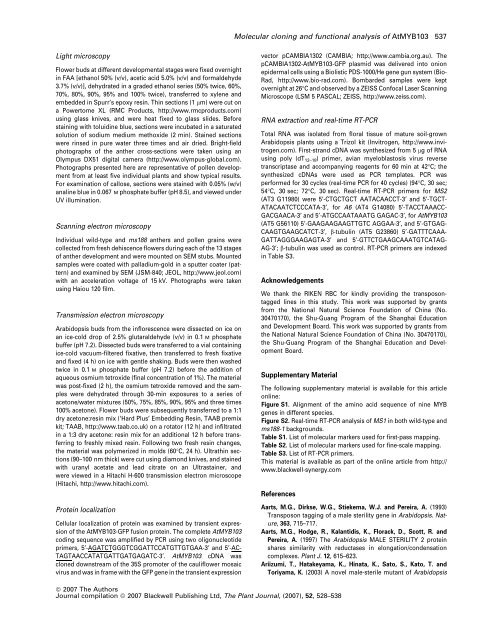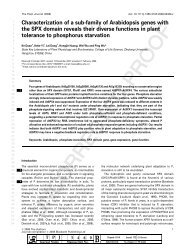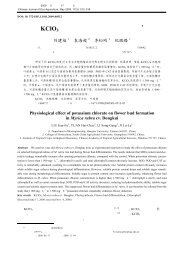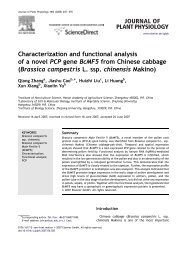You also want an ePaper? Increase the reach of your titles
YUMPU automatically turns print PDFs into web optimized ePapers that Google loves.
Molecular cloning and functional analysis of AtMYB103 537<br />
Light microscopy<br />
Flower buds at different developmental stages were fixed overnight<br />
in FAA [ethanol 50% (v/v), acetic acid 5.0% (v/v) and formaldehyde<br />
3.7% (v/v)], dehydrated in a graded ethanol series (50% twice, 60%,<br />
70%, 80%, 90%, 95% and 100% twice), transferred to xylene and<br />
embedded in Spurr’s epoxy resin. Thin sections (1 lm) were cut on<br />
a Powertome XL (RMC Products, http://www.rmcproducts.com)<br />
using glass knives, and were heat fixed to glass slides. Before<br />
staining with toluidine blue, sections were incubated in a saturated<br />
solution of sodium medium methoxide (2 min). Stained sections<br />
were rinsed in pure water three times and air dried. Bright-field<br />
photographs of the anther cross-sections were taken using an<br />
Olympus DX51 digital camera (http://www.olympus-global.com).<br />
Photographs presented here are representative of pollen development<br />
from at least five individual plants and show typical results.<br />
For examination of callose, sections were stained with 0.05% (w/v)<br />
analine blue in 0.067 M phosphate buffer (pH 8.5), and viewed under<br />
UV illumination.<br />
Scanning electron microscopy<br />
Individual wild-type and ms188 anthers and pollen grains were<br />
collected from fresh dehiscence flowers during each of the 13 stages<br />
of anther development and were mounted on SEM stubs. Mounted<br />
samples were coated with palladium-gold in a sputter coater (pattern)<br />
and examined by SEM (JSM-840; JEOL, http://www.jeol.com)<br />
with an acceleration voltage of 15 kV. Photographs were taken<br />
using Haiou 120 film.<br />
Transmission electron microscopy<br />
Arabidopsis buds from the inflorescence were dissected on ice on<br />
an ice-cold drop of 2.5% glutaraldehyde (v/v) in 0.1 M phosphate<br />
buffer (pH 7.2). Dissected buds were transferred to a vial containing<br />
ice-cold vacuum-filtered fixative, then transferred to fresh fixative<br />
and fixed (4 h) on ice with gentle shaking. Buds were then washed<br />
twice in 0.1 M phosphate buffer (pH 7.2) before the addition of<br />
aqueous osmium tetroxide (final concentration of 1%). The material<br />
was post-fixed (2 h), the osmium tetroxide removed and the samples<br />
were dehydrated through 30-min exposures to a series of<br />
acetone/water mixtures (50%, 75%, 85%, 90%, 95% and three times<br />
100% acetone). Flower buds were subsequently transferred to a 1:1<br />
dry acetone:resin mix (‘Hard Plus’ Embedding Resin, TAAB premix<br />
kit; TAAB, http://www.taab.co.uk) on a rotator (12 h) and infiltrated<br />
in a 1:3 dry acetone: resin mix for an additional 12 h before transferring<br />
to freshly mixed resin. Following two fresh resin changes,<br />
the material was polymerized in molds (60°C, 24 h). Ultrathin sections<br />
(90–100 nm thick) were cut using diamond knives, and stained<br />
with uranyl acetate and lead citrate on an Ultrastainer, and<br />
were viewed in a Hitachi H-600 transmission electron microscope<br />
(Hitachi, http://www.hitachi.com).<br />
Protein localization<br />
Cellular localization of protein was examined by transient expression<br />
of the AtMYB103-GFP fusion protein. The complete AtMYB103<br />
coding sequence was amplified by PCR using two oligonucleotide<br />
primers, 5¢-AGATCTGGGTCGGATTCCATGTTGTGAA-3¢ and 5¢-AC-<br />
TAGTAACCATATGATTGATGAGATC-3¢. AtMYB103 cDNA was<br />
cloned downstream of the 35S promoter of the cauliflower mosaic<br />
virus and was in frame with the GFP gene in the transient expression<br />
vector pCAMBIA1302 (CAMBIA; http://www.cambia.org.au). The<br />
pCAMBIA1302-AtMYB103-GFP plasmid was delivered into onion<br />
epidermal cells using a Biolistic PDS-1000/He gene gun system (Bio-<br />
Rad, http://www.bio-rad.com). Bombarded samples were kept<br />
overnight at 26°C and observed by a ZEISS Confocal Laser Scanning<br />
Microscope (LSM 5 PASCAL; ZEISS, http://www.zeiss.com).<br />
RNA extraction and real-time RT-PCR<br />
Total RNA was isolated from floral tissue of mature soil-grown<br />
Arabidopsis plants using a Trizol kit (Invitrogen, http://www.invitrogen.com).<br />
First-strand cDNA was synthesized from 5 lg of RNA<br />
using poly (dT 12–18 ) primer, avian myeloblastosis virus reverse<br />
transcriptase and accompanying reagents for 60 min at 42°C; the<br />
synthesized cDNAs were used as PCR templates. PCR was<br />
performed for 30 cycles (real-time PCR for 40 cycles) (94°C, 30 sec;<br />
54°C, 30 sec; 72°C, 30 sec). Real-time RT-PCR primers for MS2<br />
(AT3 G11980) were 5¢-CTGCTGCT AATACAACCT-3¢ and 5¢-TGCT-<br />
ATACAATCTCCCATA-3¢, for A6 (AT4 G14080) 5¢-TACCTAAACC-<br />
GACGAACA-3¢ and 5¢-ATGCCAATAAATG GAGAC-3¢, for AtMYB103<br />
(AT5 G56110) 5¢-GAAGAAGAAGTTGTC AGGAA-3¢, and 5¢-GTGAG-<br />
CAAGTGAAGCATCT-3¢, b-tubulin (AT5 G23860) 5¢-GATTTCAAA-<br />
GATTAGGGAAGAGTA-3¢ and 5¢-GTTCTGAAGCAAATGTCATAG-<br />
AG-3¢; b-tubulin was used as control. RT-PCR primers are indexed<br />
in Table S3.<br />
Acknowledgements<br />
We thank the RIKEN RBC for kindly providing the transposontagged<br />
lines in this study. This work was supported by grants<br />
from the National Natural Science Foundation of China (No.<br />
30470170), the Shu-Guang Program of the Shanghai Education<br />
and Development Board. This work was supported by grants from<br />
the National Natural Science Foundation of China (No. 30470170),<br />
the Shu-Guang Program of the Shanghai Education and Development<br />
Board.<br />
Supplementary Material<br />
The following supplementary material is available for this article<br />
online:<br />
Figure S1. Alignment of the amino acid sequence of nine MYB<br />
genes in different species.<br />
Figure S2. Real-time RT-PCR analysis of MS1 in both wild-type and<br />
ms188-1 backgrounds.<br />
Table S1. List of molecular markers used for first-pass mapping.<br />
Table S2. List of molecular markers used for fine-scale mapping.<br />
Table S3. List of RT-PCR primers.<br />
This material is available as part of the online article from http://<br />
www.blackwell-synergy.com<br />
References<br />
Aarts, M.G., Dirkse, W.G., Stiekema, W.J. and Pereira, A. (1993)<br />
Transposon tagging of a male sterility gene in Arabidopsis. Nature,<br />
363, 715–717.<br />
Aarts, M.G., Hodge, R., Kalantidis, K., Florack, D., Scott, R. and<br />
Pereira, A. (1997) The Arabidopsis MALE STERILITY 2 protein<br />
shares similarity with reductases in elongation/condensation<br />
complexes. Plant J. 12, 615–623.<br />
Ariizumi, T., Hatakeyama, K., Hinata, K., Sato, S., Kato, T. and<br />
Toriyama, K. (2003) A novel male-sterile mutant of Arabidopsis<br />
ª 2007 The Authors<br />
Journal compilation ª 2007 Blackwell Publishing Ltd, The Plant Journal, (2007), 52, 528–538








